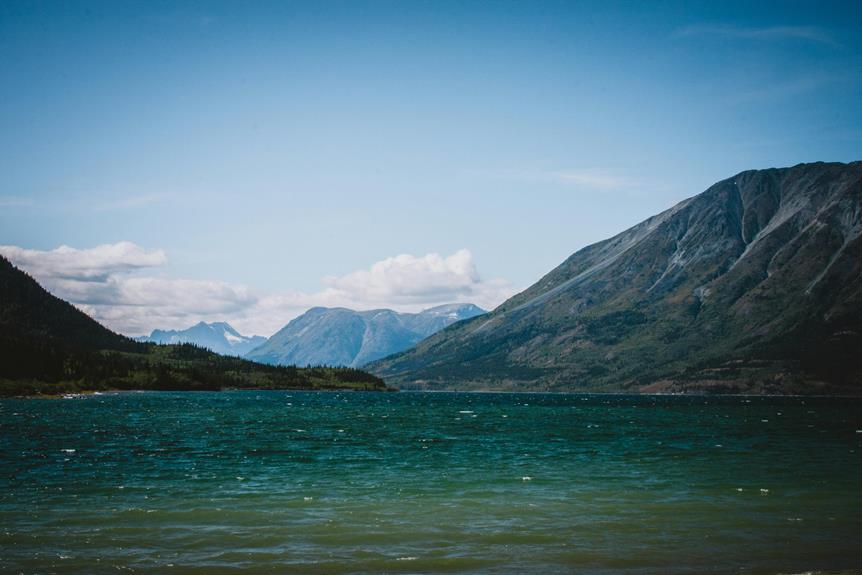Nestled in the rugged landscapes of southeastern Alaska, Lituya Bay stands as a testament to the raw power of nature and the resilience of its inhabitants. This remote bay, with its steep cliffs and ancient geological formations, holds a storied past that intrigues researchers and adventurers alike. From the cataclysmic events that shaped its shores to the delicate balance of its marine ecosystem, Lituya Bay beckons those curious minds willing to uncover the mysteries hidden within its depths.
Key Takeaways
- Lituya Bay is in southeastern Alaska with rugged terrain and steep cliffs.
- The bay was formed millions of years ago by glacial processes and tectonic forces.
- The 1958 tsunami, triggered by a massive landslide, reached waves up to 1,720 feet.
- It is home to a rich marine ecosystem with diverse species like Humpback Whales and King Crabs.
- Glacial activity impacts the bay, causing coastal erosion and altering the landscape.
Geographic Location
Situated in the southeastern region of Alaska, Lituya Bay is a fjord known for its rugged terrain and dramatic natural beauty. The geographic features of Lituya Bay are characterized by steep, glacier-carved cliffs that rise dramatically from the waters below. The bay is surrounded by towering mountains that contribute to its secluded and pristine atmosphere. These topographic characteristics create a unique and awe-inspiring landscape that attracts adventurers and nature enthusiasts seeking freedom and exploration.
Lituya Bay's geographic location also plays an essential role in shaping its weather patterns and overall climate. The bay's positioning along the southeastern coast of Alaska exposes it to the influences of the Gulf of Alaska, resulting in a maritime climate with significant rainfall and moderate temperatures. This environment supports lush vegetation and diverse wildlife, adding to the bay's allure for those looking to experience the untamed beauty of the Alaskan wilderness.
Moreover, Lituya Bay's geographic features and topographic characteristics have made it a site of interest for researchers studying coastal geomorphology and glacial processes. The bay's unique combination of rugged terrain, fjords, and glaciers provides valuable insights into the dynamic forces that have shaped the region over millennia. By studying Lituya Bay's geology and landforms, scientists can better understand the complex interactions between ice, water, and land in this remote and pristine corner of the world.
Formation and Geology
The formation and geology of Lituya Bay reveal a complex interplay of tectonic forces and glacial processes that have sculpted its distinctive landscape over time. Lituya Bay is situated within the Pacific Ring of Fire, a region known for its tectonic activity. The bay's formation process began millions of years ago when tectonic plates collided, leading to the uplift of the land and the creation of the bay's deep, narrow inlet. The rock layers exposed in the cliffs surrounding Lituya Bay provide valuable insights into the area's geological history.
The bay's geology is primarily composed of metamorphic and igneous rocks, indicating a history of intense heat and pressure within the Earth's crust. These rock layers have been folded and faulted by tectonic forces, creating the rugged terrain seen in the bay today. Glacial processes further shaped Lituya Bay during the last Ice Age, as massive glaciers advanced and retreated, scouring the landscape and carving out the bay's fjords and steep cliffs.
The unique combination of tectonic forces and glacial processes has contributed to the stunning beauty and geological richness of Lituya Bay. Studying the rock layers and formations within the bay provides scientists with a window into the Earth's dynamic past and the ongoing processes that continue to shape this remarkable coastal environment.
Tsunami of 1958
In 1958, Lituya Bay in Alaska experienced a devastating tsunami triggered by a massive landslide. This event, known as the Lituya Bay megatsunami, was one of the largest and most destructive tsunamis in recorded history. The tsunami was a result of a rockfall that plunged into the bay, displacing an immense volume of water and generating waves that reached staggering heights.
Here are some key points regarding the causes and impact of the tsunami:
- Causes:
- The tsunami was primarily triggered by a massive landslide that occurred on July 9, 1958.
- The landslide, estimated to be around 40 million cubic yards of rock, fell from an elevation of approximately 3,000 feet into the Gilbert Inlet of Lituya Bay.
- The impact of the rockfall into the bay displaced an enormous amount of water, leading to the formation of destructive waves.
- Impact:
- The waves generated by the landslide reached heights of up to 1,720 feet along the bay's shores, making it the tallest tsunami wave in recorded history.
- The tsunami caused extensive damage along the bay, destroying vegetation, stripping away soil, and reshaping the landscape.
- The event tragically resulted in the loss of two lives, with a father and son losing their lives aboard their fishing boat.
The Lituya Bay megatsunami of 1958 stands as a stark reminder of the raw power and destructive potential of natural events.
Marine Life and Ecosystem
Nestled within the aquatic expanse of Lituya Bay lies a rich and diverse marine ecosystem teeming with life and intricate interconnections. The bay's waters harbor a wide array of marine life, from microscopic phytoplankton to majestic whales. The ecosystem in Lituya Bay is characterized by its coral reefs, which provide essential habitats for a myriad of species, contributing greatly to the area's biodiversity.
Below the surface, Lituya Bay is home to fascinating deep-sea creatures that have evolved unique adaptations to survive in the harsh conditions of the ocean depths. These creatures, such as anglerfish with their bioluminescent lures or gulper eels with their distensible stomachs, showcase the incredible diversity and resilience of marine life in the bay.
To further illustrate the diverse marine life present in Lituya Bay, the table below provides a glimpse into some of the key species that call this ecosystem home:
| Species | Habitat | Notable Feature |
|---|---|---|
| Humpback Whale | Open Ocean | Acrobatic breaching |
| Sea Otter | Kelp Forest | Tool use for cracking shells |
| Giant Pacific Octopus | Rocky Reefs | Camouflaging abilities |
| Harbor Seal | Coastal Waters | Playful behavior |
| King Crab | Sandy Seafloor | Impressive size |
The intricate web of life in Lituya Bay highlights the interconnectedness and fragility of marine ecosystems, emphasizing the importance of conservation efforts to protect this natural wonder.
Glacial Activity
Amidst Lituya Bay's vast expanse, glacial activity shapes the landscape with relentless force, sculpting the environment in a continuous dance of ice and water. The glaciers in the surrounding mountains of Lituya Bay play an essential role in shaping the bay's features and influencing its ecosystem. Here are some key points to ponder regarding glacial activity in Lituya Bay:
- Ice Melt: The glaciers in Lituya Bay are constantly melting due to rising global temperatures, contributing to the freshwater input into the bay. This meltwater influences the bay's salinity levels and nutrient concentrations, impacting marine life.
- Coastal Erosion: Glacial activity leads to significant coastal erosion along the shores of Lituya Bay. As glaciers advance and retreat, they erode the land, shaping the coastline and depositing sediments into the bay.
- Iceberg Formation: The melting glaciers often give birth to icebergs that float into Lituya Bay. These icebergs can pose hazards to marine navigation and impact the local ecosystem.
- Glacial Retreat: Over the years, the glaciers in Lituya Bay have been retreating at an alarming rate. This retreat not only alters the bay's landscape but also affects the availability of freshwater sources for the surrounding flora and fauna.
- Climate Change Impact: The glacial activity in Lituya Bay is intricately linked to climate change. As temperatures rise, the rate of ice melt accelerates, leading to profound changes in the bay's ecosystem and morphology.
Indigenous Connections
The presence of Indigenous communities in the vicinity of Lituya Bay holds significant historical and cultural importance, establishing a deep-rooted connection to the region's past and present dynamics. The Tlingit people, whose ancestral lands encompassed the area around Lituya Bay, have a rich history intertwined with the land and waters of this region. Their cultural traditions, passed down through generations, reflect a profound respect for nature and a deep understanding of the environment.
The historical significance of the Indigenous connections to Lituya Bay is evident in the oral histories and stories that have been preserved over centuries. These narratives not only provide insights into the traditional ways of life but also offer valuable perspectives on the natural phenomena that characterize the area, such as the glacial activity that has shaped the landscape.
For the Tlingit people, Lituya Bay is more than just a geographical location; it is a place of spiritual significance and cultural heritage. The bay's waters and surrounding mountains are woven into their beliefs and traditions, serving as a reminder of their ancestors' resilience and adaptability in the face of environmental challenges. By acknowledging and honoring these Indigenous connections, we not only pay tribute to the past but also recognize the importance of preserving these cultural ties for future generations.
Exploration and Discovery
In the domain of exploration and discovery surrounding Lituya Bay, numerous expeditions have sought to unravel the mysteries of this remote and rugged Alaskan landscape. The exploration of Lituya Bay has been marked by a rich tapestry of historical significance, scientific research, cultural impact, and environmental changes. Here are some key points that shed light on the exploration and discovery in Lituya Bay:
- Historical Significance: Exploration in Lituya Bay dates back centuries, with early explorers mapping the intricate fjords and coastlines of this region.
- Scientific Research: Modern scientific expeditions have explored the unique geology and marine biology of Lituya Bay, revealing new species and geological phenomena.
- Cultural Impact: The exploration of Lituya Bay has also highlighted the cultural significance of the area to indigenous communities, illuminating traditional practices and knowledge.
- Environmental Changes: Ongoing exploration has unveiled the impact of climate change on Lituya Bay, with melting glaciers and shifting ecosystems transforming the landscape.
- Technological Advancements: Advances in technology, such as underwater drones and satellite imaging, have revolutionized exploration in Lituya Bay, enabling researchers to uncover hidden secrets of this pristine wilderness.
Through a multidisciplinary approach encompassing history, science, culture, and the environment, exploration and discovery in Lituya Bay continue to captivate and educate adventurers and researchers alike.
Recreational Activities
Engaging in various recreational activities in Lituya Bay provides visitors with a unique opportunity to immerse themselves in the pristine natural environment of this remote Alaskan landscape. The bay offers a range of activities that cater to outdoor enthusiasts seeking adventure in a breathtaking setting. Two popular recreational pursuits in Lituya Bay are hiking trails and kayaking adventures.
Recreational Activities in Lituya Bay
| Hiking Trails | Kayaking Adventures |
|---|---|
| – Explore the lush forests and rugged terrain surrounding Lituya Bay. | – Paddle through the calm waters while enjoying panoramic views of the snow-capped mountains. |
| – Encounter diverse wildlife such as bears, eagles, and marine mammals. | – Navigate through narrow fjords and witness the stunning glaciers that frame the bay. |
| – Various trails of different difficulty levels cater to both novice and experienced hikers. | – Experienced guides offer tours for beginners and advanced kayakers, ensuring a safe and memorable experience. |
Hiking trails in Lituya Bay take hikers through old-growth forests, offering a chance to witness the rich biodiversity of the region. Kayaking adventures allow visitors to glide through the pristine waters, providing a unique perspective of the bay's natural beauty. Whether hiking or kayaking, visitors can truly appreciate the untouched wilderness of Lituya Bay.
Weather and Climate
Visitors to Lituya Bay, Alaska, should be prepared for a dynamic and varied weather and climate environment that can greatly impact their outdoor recreational experiences. The region experiences a maritime climate influenced by its proximity to the ocean and the rugged terrain surrounding the bay. Here are some key factors to keep in mind concerning the weather and climate in Lituya Bay:
- Average Temperatures: Lituya Bay witnesses relatively cool temperatures throughout the year due to its northern location. Summer temperatures hover around 50-60°F (10-15°C), while winter temperatures can drop to 20-30°F (-6 to -1°C). It's essential for visitors to pack appropriate clothing for these temperature ranges.
- Marine Influence: The bay's weather is heavily influenced by the surrounding waters, leading to relatively stable temperatures compared to inland areas. However, visitors should be prepared for sudden changes in weather conditions, especially foggy mornings or rainy afternoons.
- Precipitation Patterns: Lituya Bay experiences significant rainfall, especially during the fall and winter months. Rain gear is a must for outdoor activities during these seasons to stay dry and comfortable.
- Extreme Weather Events: While rare, Lituya Bay is known for occasional extreme weather events like intense storms or high winds. Visitors should stay informed about weather forecasts and be prepared for unexpected changes.
- Microclimates: The bay's complex topography creates microclimates, resulting in varying weather conditions within short distances. It's advisable to be flexible with plans to adapt to these microclimate changes.
Conservation Efforts
How do ongoing conservation efforts in Lituya Bay, Alaska, contribute to the protection of its unique ecosystem and biodiversity?
Lituya Bay, with its rich biodiversity and fragile ecosystem, benefits greatly from focused wildlife protection measures and a commitment to sustainable tourism practices. The conservation efforts in Lituya Bay extend beyond just safeguarding its natural beauty; they aim to guarantee the long-term viability of its ecosystems.
One key aspect of conservation in Lituya Bay is the emphasis on wildlife protection. By establishing protected areas and regulating human activities, such as fishing and boating, authorities help preserve the habitats of various species, including seabirds, marine mammals, and fish. These measures are essential in maintaining the delicate balance of the ecosystem and preventing the decline of vulnerable species.
Moreover, sustainable tourism plays an important role in conservation efforts. By promoting responsible tourism practices that minimize environmental impact, such as low-impact recreational activities and waste reduction strategies, the local community can enjoy economic benefits from tourism while ensuring the preservation of Lituya Bay's natural resources for future generations.
Local community engagement and environmental education programs further enhance conservation efforts in Lituya Bay. By involving residents in conservation projects and providing educational opportunities about the importance of biodiversity and ecosystem health, a sense of stewardship is fostered among the community, leading to increased support for conservation initiatives. This collaborative approach ensures that the conservation efforts in Lituya Bay are not only effective but also sustainable in the long run.
Frequently Asked Questions
How Deep Is Lituya Bay's Deepest Point?
The depth of a bay's deepest point is essential for understanding its ecosystem and geology. This information is important for exploring marine life distribution, underwater geology, and the overall ecological dynamics of the area.
These depths provide insight into habitat diversity, nutrient availability, and geological formations that shape marine life. Conducting detailed surveys and measurements of these depths is necessary for thorough research and conservation efforts in marine environments.
Are There Any Rare Species Found in Lituya Bay?
Endangered species are a critical focus in conservation efforts worldwide. Identifying biodiversity hotspots, such as Lituya Bay, provides valuable research opportunities for studying rare species and implementing targeted conservation measures.
Understanding the presence of unique and endangered species in these areas is essential for preserving biodiversity and ecosystem health. Conservation efforts in such locations aim to safeguard these species and their habitats for future generations while expanding scientific knowledge through research initiatives.
What Recreational Activities Are Prohibited in the Bay?
Certain recreational activities in the bay are designed to safeguard the local ecosystem. Fishing restrictions are implemented to preserve fish populations and their habitats.
Boating regulations aim to prevent disturbance to marine life and maintain safety within the bay. These measures guarantee sustainable enjoyment of the area while safeguarding its natural resources.
It is important for visitors to adhere to these guidelines to support the conservation efforts in the bay.
Is There a Specific Time of Year to Witness Glacial Activity?
Glacial calving, a process where large chunks of ice break off glaciers and fall into the water, usually occurs during the warmer months. Scientific research indicates that glacial activity can be observed more frequently during summer due to higher temperatures.
However, climate change is causing glaciers to melt at an accelerated rate, impacting the environment. Understanding the timing and frequency of glacial calving events is essential for studying the effects of climate change on glacial ecosystems.
What Are the Measures Taken to Protect the Bay From Pollution?
Environmental regulations play an essential role in safeguarding natural habitats worldwide. Measures to protect bays from pollution often involve stringent guidelines on waste disposal, industrial emissions, and shipping practices.
Community involvement is equally pivotal, with local initiatives focusing on clean-up efforts, educational programs, and advocacy for sustainable practices.
Conclusion
Lituya Bay in Alaska, known for its dramatic landscape and rich marine life, has been shaped by geologic processes and natural forces.
Despite facing challenges like glacial retreat and coastal erosion, the bay remains a unique and vibrant ecosystem.
Conservation efforts are essential to preserving this valuable habitat for future generations.
The bay's beauty and biodiversity stand in stark contrast to the threats it faces, highlighting the importance of sustainable management practices.


